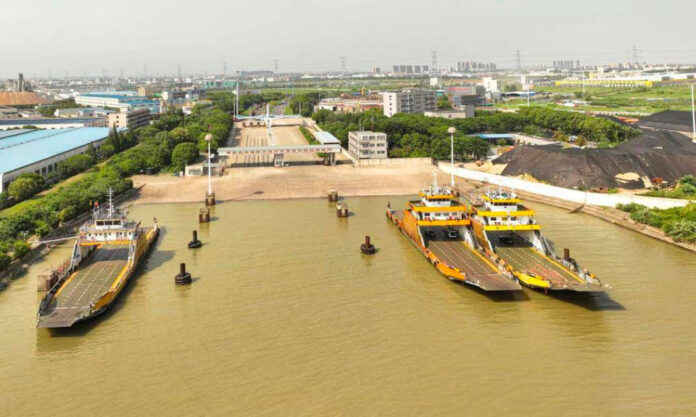They were for many years a lifeline between the north and south of Jiangsu, separated by the mighty Yangtze River. For many along the Yangtze’s downstream, it was either the ferry or a very long trip up to Nanjing where there was the only bridge. Times have changed.
On 2 July, the cities of Nantong and Changshu in Jiangsu issued announcements as to a temporary suspending of ferry services. This was followed on 5 July by simultaneous announcements, in a somewhat emotional tone, that services would end permanently.
The reason given for the suspension of sailings? “The ferry does not meet the conditions for safe operation.” And the date chosen? The ferry’s 30th birthday, so as to leave a special and complete historical memory.
But nothing, in this case, can hide the truth.
From Qidu Wharf today, giant ships continue their infrequent shuttle across the river with vehicles on board few and far between, while three ferries nearby lie old and mottled. Daily losses stand in excess of ¥20,000.
Backing up to before the ferry’s birth, in the 1990s, the economy of southern Jiangsu was developing rapidly, but Nantong on the northern bank had literally no hand to play in the new game called prosperity.
Nantong City therefore decided in 1992 to build a vehicular ferry, officially opening out of Nantong Farm on 10 July, 1993, as the Yangtze Evening News reports.
As the millennium turned, and in order to achieve faster crossings, a new home was sought for the ferry. Moving south to its current location in 2004, the ferry virtually halved its crossings’ distance and time required, to 6 kilometres and 25 minutes.
Lu Yonghua, 55, has worked for the ferry since it moved to Qidu Wharf. He recalled the golden years, voices crying out all around and the fast-food vendors on the shore making pots of money.
The good times lasted until 2008, when the Sutong Bridge, ironically built adjacent and with the ferry looking on disapprovingly, was completed and opened to traffic.
During those golden years, each ferry could make more than 40 round-trip voyages per day, and voyages per day totalled around 500. But now, with bridges all around, there are only 50-60 voyages per day. Vehicle numbers are less than 10 percent of that they once were.
The ferry may be closing, but it shall never disappear from the waterway. The ships are to be maintained for supplementary and emergency use, and for combat readiness. And that cannot be replaced by bridges and tunnels.









